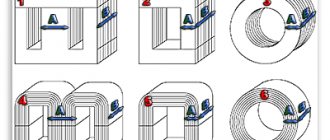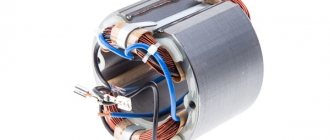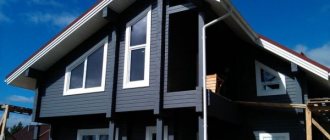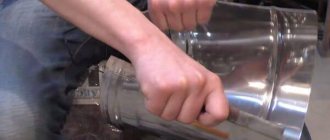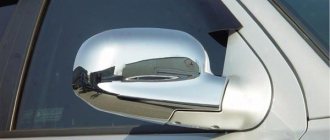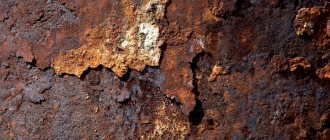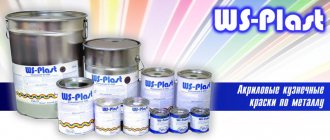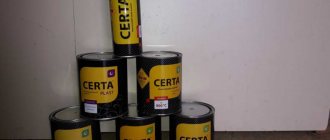Painting surfaces is a popular way to change their appearance in order to give them a better aesthetic perception. In addition, this technique allows you to obtain a protective layer from various types of negative influences, this also applies to metal parts. Usually it is important to paint on the same day, then there will be no discrepancies in shades, so you need to immediately purchase the right amount of paint. Accordingly, you need to calculate the paint consumption per 1 m2 of metal, taking into account various factors. How to make the calculations correctly will be discussed below.
Consumption rates depending on the type of metal paints
The manufacturer's information will help you make the correct calculation of enamel consumption.
The manufacturer's information will help you make the correct calculation of enamel consumption. Each type of paint for metal work has a different thickness, elasticity and hiding power, which affects consumption rates. To determine the required amount, use a calculator to multiply the consumption per m² by the area of the surface to be painted and the number of layers. The following average figures for different types of coloring materials will simplify the procedure.
Important! 5% should be added to the resulting amount to avoid a lack of coloring composition when dyeing
Oil paint
When using oil paint, it is important to take into account the topography of the base when calculating the area. The color of the enamel also has a significant impact, since light colors are applied in 2-3 layers, which will increase the cost per meter of surface. The average consumption of oil paint per 1 m² is 130-140 g. for each layer.
Primer-enamel
An effective multifunctional product for interior and exterior painting – enamel primer. The coating acts as a primer and can transform rust on metal. Primer enamel is also a decorative layer. An average of 80-120 grams is spent per 1 m². material. To create a good protective layer against rust, the composition should be applied in several passes, which will affect costs.
Enamel PF-115
The composition based on alkyd resins is popular due to its fast drying speed and versatility. The paint consumption per 1 m² is affected by the degree of preparation of the base and the chosen shade. Light coloring compounds should be applied in several layers. According to professionals, a kilogram container is enough to paint 15 m². The consumption rate of PF-115 paint is 100-180 g. per square meter.
Powder paint
A special type of coloring materials, which differs in quality characteristics and application method. This affects material consumption. Powder dyes are designed to create a super-durable coating, so there are requirements for the thickness of the applied layer. It must be at least 100 microns. The weight of the mixture should also be taken into account. Less weight means less costs. Powder paint consumption per 1 m² for metal is 120-140 g.
Hammer paint
An expensive type of paint and varnish materials, which are often used for painting metal surfaces. The cost is due to its high protective qualities. With this composition you can reliably protect metal from rust. The coating resembles embossing in appearance. Paint consumption per 1 m² of metal is 100 ml.
Rubber paint
When applied to a metal surface, rubber paints and varnishes form an elastic coating resembling rubber. A layer of coloring composition effectively protects the metal from negative external influences. The cost of such products is high, the consumption is also increased to 200 ml per m². Such paints and varnishes are used for painting small surfaces that require special protection.
Acrylic paint
Painting materials based on acrylates have high protective characteristics. This coating is fireproof, weatherproof, and has a long service life. On average, 120-180 grams are used per 1 m². acrylic paint.
Standards for wasting enamel
PF-115 paint and its consumption per 1m2
LKM PF 115 is used in both external and internal processes. This is, by definition, an enamel paint, which is mostly used for metal objects. If you read the description of the material, you will notice that it has a number of excellent properties:
- Not afraid of negative atmospheric influences
- Moisture resistant
- Protected from UV rays
- Not afraid of the wind
But for these properties there is a small nuance; the paint receives all its excellent characteristics only after application and complete drying of the surface. But when applied, it is subject to all of the above influences and, of course, in order to avoid incidents it must be protected as much as possible. Metal enamel PF 115 will be consumed per m2 in larger quantities if application occurs in windy and sunny weather.
The consumption of enamel on metal depends on the color you choose, and so I decided to make a small and understandable sign:
| PF 115 Enamel consumption per m2 | |
| Black color | 17-20 m2 |
| Blue enamel | 12-17 |
| Brown | 13-16 |
| Green | 11-14 |
| White | 7-10 |
| Yellow | 5-10 |
If painting is done in bright sun, then prepare for the fact that the consumption per 1 m2 will increase greatly due to the evaporation of the enamel. I don’t want to talk about specifics, since there are cases when the indicators literally double. Therefore, if you do not want to spend money on purchasing paint, then adapt to the weather. If you look at the table, then simply divide all the m2 data by two and get the area that will be painted in bad weather conditions.
What tool is used
The method of applying paintwork plays an important role in calculating consumption; for example, brushes are considered the most wasteful.
The paint remains on the fluff and drips onto the floor. It is quite difficult to apply the coating evenly. An expensive but economical option is to use a spray gun. With its help, you can control the consumption of the coloring agent, make the layer even, without smudges or omissions. The installation itself is expensive, but you can save on paint consumption.
If the spray option is not suitable, professionals advise using a silicone-based roller. The tool will reduce paint consumption. And when you combine a roller with a special tray with ribbed edges, you can reduce costs even more.
Dye for normal and thick (coarse) hair
For strong, normal and coarse hair, permanent and semi-permanent professional dyes with a gentle formula that does not damage the hair structure may be suitable.
The paint should not injure the bulbs and scalp. Therefore, they should contain vitamins, plant extracts, waxes and oils to improve blood circulation and nourish hair, protect against ultraviolet radiation and retain moisture.
It is better to choose a rich dye that changes the natural color by 3-6 shades and covers gray hair.
The following professional products are suitable for coarser and thicker hair:
- Goldwell Kerasilk Ultra Rich Care line with silk proteins. The product moisturizes, strengthens and restores hair structure, has a particularly beneficial effect on dry and damaged hair;
- premium German cosmetics GOLDWELL, the colors of which have a wide range of styles and new technologies;
- AWESOMECOLORS line with a wide palette of permanent and semi-permanent colors, including the unique Silky-Shine Complex product with effective protection: three wheat proteins, vitamin C, extracts and oils from medicinal herbs, beeswax and candepil wax. After dyeing, the hair combs well, shines, and becomes elastic.
Weather
The staining conditions are usually prescribed by the manufacturer. Recommendations for humidity and temperature conditions should be strictly followed. Some formulations are designed for use at low temperatures. The following parameters are considered optimal for painting metal:
- humidity – 75-80%
- temperature - +5-+20°C.
In this case, you should avoid direct sunlight and wind, which will negatively affect the result. High humidity or wind can increase costs several times. Painting indoors, subject to regulatory standards, will bring the level of material consumed closer to the indicator specified by the manufacturer.
It should be borne in mind that in any case there is loss of coloring agent when:
- painting indoors – 5%;
- normal humidity, outside temperature – 5%;
- high humidity, strong wind – 20%.
The best time for exterior painting is morning or evening, when there is no direct sunlight.
Where should a modifier primer not be used?
Scale is resistant to phosphoric acid, so applying a primer containing a rust converter to such surfaces is not recommended. If black rust has formed on the surface, this indicates that the alloy contains magnetite, which is also resistant to modifiers.
You cannot use compositions with rust modifiers on surfaces where oxidation has occurred partially and most of it is metal without corrosion. Uncleaned paint, like scale, will also not interact with the converter, and the primer will not be able to penetrate through it. If during operation the metal structure was exposed to sulfur, hydrogen sulfide or ammonia compounds, then the use of a primer based on orthophosphoric acid is also inappropriate.
Quality of the painted surface
New metal surfaces require less paint. For old, previously painted substrates with traces of corrosion, careful preparation will be required. This will reduce the cost of consumable materials.
Covering power of the mixture and base color
One of the key characteristics of coloring materials is hiding power.
Paints with a high index can quickly hide the original color of a metal product, therefore, less of them will be needed. Compounds with low opacity require multiple layers to achieve perfect coverage. As for color, the chosen tone also affects the material consumption. Light-colored compounds paint the base worse, so it is necessary to apply 2-3 layers of coating. Dark formulations hide the base faster, so the consumption is less. The original color of the metal plays a role. Painting dark shades will require more layers, which means the consumption will be higher.
To calculate the required consumption of coloring material, the parameters indicated by the manufacturer on the can are important.
Additional factors affecting the costs of coatings should also be taken into account. It is possible to find out the exact costs of paint and varnish material for metal per 1 m² only by test painting. For an approximate calculation, you should use a simple formula: multiply the surface area by the number of layers and multiply by the material consumption from the manufacturer.
Choosing the right brush
The consumption of paint and varnish material depends not least on the choice of brush. You will have to choose between brushes with synthetic or combined bristles. The brush can have a long or flat handle.
A brush with natural bristles is better suited for working with organic solvents. Its pile absorbs the dye well and distributes the composition evenly over the surface. However, for water-dispersion paints, natural bristles are not the best option, since they become saturated with water too quickly and become shapeless, which makes painting inconvenient. Unlike natural bristles, artificial bristles do not absorb liquid and retain their original shape during the working process.
Note! A high-quality brush is characterized not only by good absorption, but also by the same return of paint.
An example of calculating the area of the walls of a room
You can calculate the required amount of materials for painting walls as follows. If there is a room with a standard ceiling height of 2.5 m, a width of 3 m and a length of 5 m, then to calculate its area, you should determine the perimeter and multiply it by the height of the room.
In the above example, the perimeter will be (3+5)*2=16 m, and the area will be 16*2.5 = 40 m². From the specified size, you should exclude the area of those surfaces that will not be painted - doors, windows. On average they occupy about 3-4 m².
It is advisable to buy paint with a reserve. Its consumption does not always coincide with that indicated by manufacturers on the packaging.
